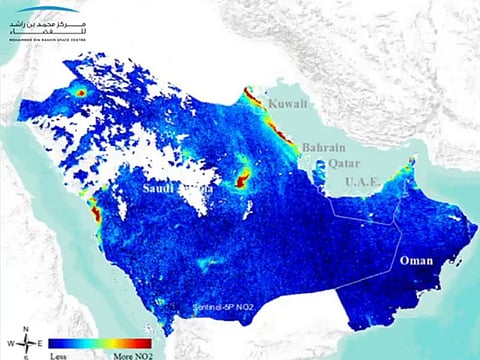Coronavirus: Dubai Sat image proves NO2 decline in GCC
Curfew and COVID-19 preventive measures in air space, roads leads to drop in pollution

Dubai: A recent image captured by the Mohammed Bin Rashid Space Centre (MBRSC) has shown a significant drop in nitrogen dioxide (NO2) emissions across GCC countries.
Air pollutants in the Gulf region were recorded between November 26, 2019 and March 27, 2020.
The Remote Sensing Department at MBRSC published the results using data acquired by the European Space Agency's (ESA) Sentinel-5P mission. The drop in NO2 concentrations beginning late-February coincides with the region-wide precautionary measures taken to prevent the spread of coronavirus.
Nitrogen dioxide is mainly produced from engines, power generation and other industrial processes, according to the World Health Organisation (WHO). In view of the lockdown announced in various countries, fewer vehicles are on the road, fewer planes are taking flight and industries have also been affected over the period. This has led to the decline in NO2 concentrations, which in turn has improved air quality.
In order to curb the spread of the COVID-19 outbreak, countries across the world are implementing strict measures – placing cities and even countries on lockdown.
According to a study published by the ESA, the Copernicus Sentinel-5P satellite has recently mapped air pollution across Europe and China and revealed a significant drop in nitrogen dioxide concentrations, which coinciding with the strict quarantine measures.
The new images clearly illustrate a strong reduction of nitrogen dioxide concentrations over major cities across Europe – specifically Milan, Paris and Madrid.
The satellite images show nitrogen dioxide concentrations from 14 to 25 March 2020, compared to the monthly average of concentrations from 2019.
Air pollution is the single greatest environmental threat to health in the world, according to the United Nations.
Every year, 6.5 million people die from exposure to indoor and outdoor air pollution, and nine out of 10 people breathe contaminated outdoor air that exceeds the acceptable levels set by the WHO guidelines. The effects of air pollution are not limited to health only, but extend to other economic and social aspects.
Sign up for the Daily Briefing
Get the latest news and updates straight to your inbox






